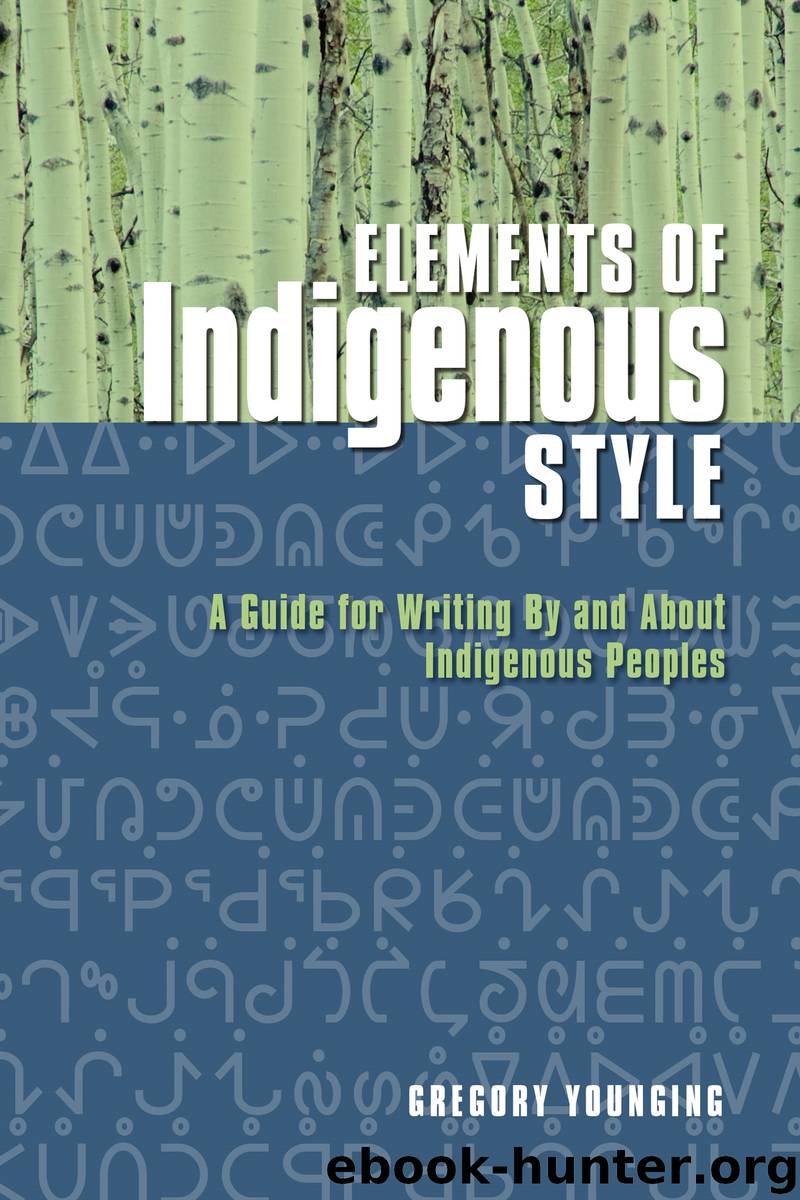Elements of Indigenous Style by Gregory Younging

Author:Gregory Younging
Language: eng
Format: epub
Publisher: Brush Education
Capitalized terms for Indigenous institutions
Chief
He is Chief of Driftpile Cree Nation.
Several Chiefs attended the First Ministers conference.
Clan; Clan System; Matriarch
The Haudenosaunee Confederacy has a total of nine Clans. Three Clans are common to all member nations, and five Clans are common to two or three member nations. A ninth Clan, the Eel Clan, is unique to the Onondaga.
The Clan System is a matrilineal social and political institution of the Haudenosaunee Confederacy.
She is Matriarch of the Bear Clan.
Creator; Creation
The meeting began with a prayer to the Creator.
People have a responsibility to care for Creation.
Elder
The students start every day by smudging, led by an Elder from the community.
Indigenous Voice
The Indigenous Voice is among the literatures of the world, and comes from Indigenous Peoples speaking for themselves, with connection to their past, present, and future, and in an evolving conversation with their Traditional Knowledge and Oral Traditions.
Longhouse
The Longhouse is a democratic institution based on consensus.
But: Many families lived together in longhouses, which were the living quarters of people of the same Clan.
Medicine Man; Medicine Woman
Medicine Men and Medicine Women have spiritual significance in Indigenous societies.
Midewiwin/Midewin
Like Christianity, Midewiwin is a religion.
Oral Tradition
The Oral Tradition of the Secwepemc includes a Traditional Story about the creation of salmon.
Respect for Oral Traditions includes following cultural Protocols about Sacred Stories and seasonal stories, such as Winter Stories and Summer Stories.
Potlatch
Guests play an important role in the Potlatch as witnesses to gifts that acknowledge a family’s inheritance.
The family held a Potlatch to honour the passing of the Elder.
But: The family potlatched to name their first son.
Protocols (cultural)
Indigenous Peoples have cultural Protocols about respecting Elders and Oral Traditions.
Sacred Pipe Ceremony; Pipe Carrier
During the Sacred Pipe Ceremony, the people prayed not only for their own well-being, but for that of all human beings and the whole of Creation.
The Pipe Carrier, entrusted with the care of the Sacred Pipe on behalf of the people, brought the Sacred Pipe to the centre of the circle and unwrapped it.
Seven Fires
The Oral Tradition of the Anishinaabe records the prophecy of the Seven Fires, which is also recorded in a Wampum Belt.
Sundance
No filming or photography is allowed during the Sundance, which is a sacred ceremony held during the summer.
Sweat Lodge
Amiskwaciy Academy invites Edmontonians to experience the spiritual, physical, and emotional cleansing of the Sweat Lodge as part of reconciliation.
Traditional Knowledge
The preferred method of harvesting wild rice by hand—by poling a canoe and knocking the rice—is part of the Traditional Knowledge of the Anishinaabe.
Vision Quest
The young man is going on a Vision Quest, where he will fast alone, and seek spiritual guidance and purpose.
Warrior Society
During the traditional hunts of the Plains Cree, the Warrior Society maintained discipline.
Wampum; Wampum Belt
In 1989, New York State returned twelve Wampum Belts to the Onondaga.
Guswenta (Kaswentha), the Two Row Wampum, records a treaty that began in 1613 between the Haudenosaunee and European settlers.
Download
This site does not store any files on its server. We only index and link to content provided by other sites. Please contact the content providers to delete copyright contents if any and email us, we'll remove relevant links or contents immediately.
| Anthropology | Archaeology |
| Philosophy | Politics & Government |
| Social Sciences | Sociology |
| Women's Studies |
Cecilia; Or, Memoirs of an Heiress — Volume 1 by Fanny Burney(32061)
Cecilia; Or, Memoirs of an Heiress — Volume 3 by Fanny Burney(31455)
Cecilia; Or, Memoirs of an Heiress — Volume 2 by Fanny Burney(31408)
The Great Music City by Andrea Baker(30780)
We're Going to Need More Wine by Gabrielle Union(18631)
All the Missing Girls by Megan Miranda(14725)
Pimp by Iceberg Slim(13777)
Bombshells: Glamour Girls of a Lifetime by Sullivan Steve(13683)
Fifty Shades Freed by E L James(12910)
Talking to Strangers by Malcolm Gladwell(12869)
Norse Mythology by Gaiman Neil(12825)
For the Love of Europe by Rick Steves(11456)
Crazy Rich Asians by Kevin Kwan(8886)
Mindhunter: Inside the FBI's Elite Serial Crime Unit by John E. Douglas & Mark Olshaker(8699)
The Lost Art of Listening by Michael P. Nichols(7159)
Enlightenment Now: The Case for Reason, Science, Humanism, and Progress by Steven Pinker(6871)
The Four Agreements by Don Miguel Ruiz(6314)
Bad Blood by John Carreyrou(6275)
Weapons of Math Destruction by Cathy O'Neil(5829)
